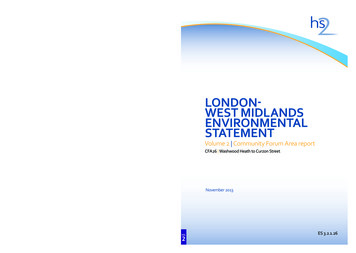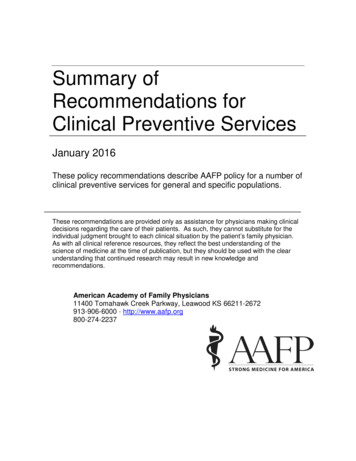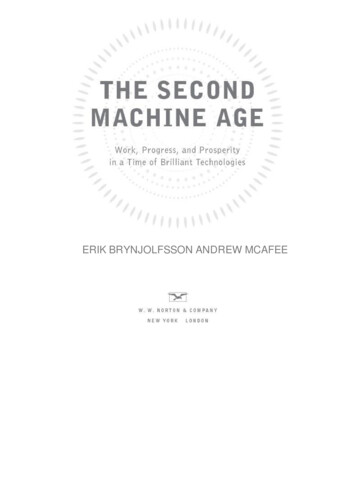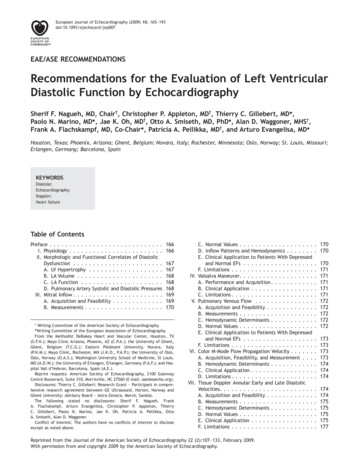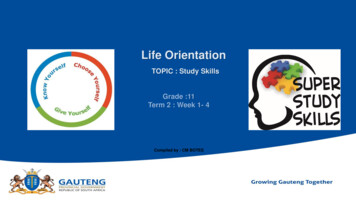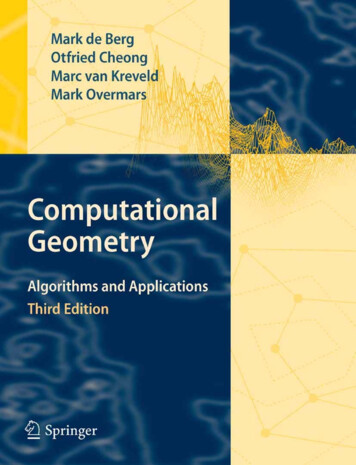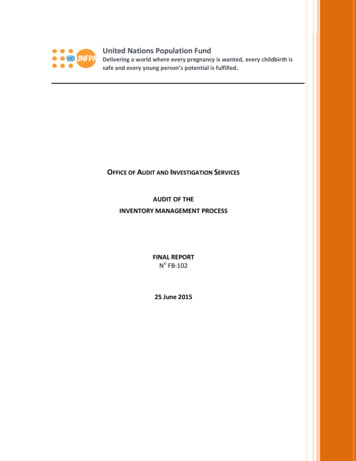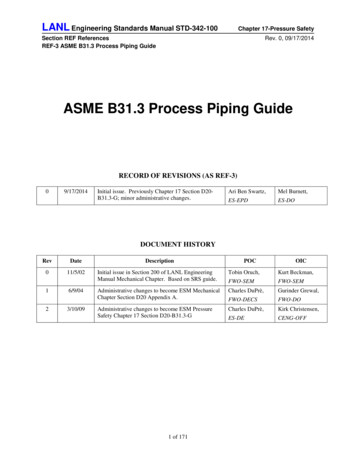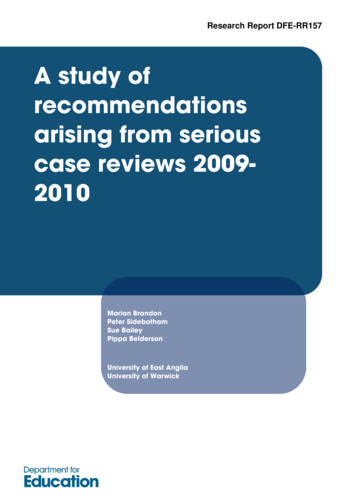
Transcription
Research Report DFE-RR157A study ofrecommendationsarising from seriouscase reviews 20092010Marian BrandonPeter SidebothamSue BaileyPippa BeldersonUniversity of East AngliaUniversity of Warwick
This research report was commissioned before the new UK Government took office on11 May 2010. As a result the content may not reflect current Government policy and maymake reference to the Department for Children, Schools and Families (DCSF) which hasnow been replaced by the Department for Education (DFE).The views expressed in this report are the authors’ and do not necessarily reflect thoseof the Department for Education.
ACKNOWLEDGEMENTSThe research team would like to extend our thanks to the Department for Education for theirsupport in overseeing this project, particularly Jenny Gray, Isabella Craig and JulieWilkinson. Thanks are also due to the advisory group for their helpful advice andsuggestions and to Jane Black from Norfolk LSCB and Ruth Pearson from SheffieldUniversity for offering advice during the final drafting phase of the study.AUTHORSDr Marian Brandon, Sue Bailey and Dr Pippa Belderson are members of the Centre forResearch on the Child and Family in the School of Social Work and Psychology at theUniversity of East Anglia, Dr Peter Sidebotham is a member of the Health SciencesResearch Institute at the University of Warwick.
CONTENTSExecutive Summary1Chapter 1: Literature Context, Aims and Methodology6Chapter 2: The number of recommendations10Chapter 3: Thematic analysis of recommendations13Chapter 4: Matching the themes of the cases to the recommendations made36Chapter 5: A critique of the ‘SMART’ approach to recommendations and action plans42Chapter 6: Conclusion47List of tablesTable 1: Number of recommendations made in each of 20 Serious Case Reviews,together with the agencies addressed12Table 2: The number of overview reports addressing specific themes in therecommendationsTable 3 Extent to which themes in 20 cases are reflected in the recommendations1437List of FiguresFigure 1: Numbers of overview reports included in each stage of analysis9Figure 2: A layered approach to a consideration of recommendation themes13Figure 3: Frequency of recommendations and serious case review themes40
EXECUTIVE SUMMARYIntroductionThis small study presents a critical, thematic analysis of recommendations from 33 of theserious case reviews (cases of child death or serious injury through abuse or neglect)completed in 2009-2010. The central aim of the study was to consider what partrecommendations can play in aiding agencies and individuals ‘to learn lessons to improvethe way in which they work both individually and collectively to safeguard and promote thewelfare of children’ (HM Government 2010:246).Key findings Overall, our impression of reading recommendations from the 33 cases is that theyare indeed becoming tighter and more clearly focused, although rarely are they fewin number. In the 20 serious case reviews examined in depth, there were a total of 932recommendations with an average of 47 per review. This is in spite of repeated callsto make recommendations few in number. Breaking down recommendations into achievable actions has resulted in a furtherproliferation of tasks to be followed through. Adding new layers of prescriptive activityleaves little room for professional judgement. Most recommendations concerned procedures and training. The route to grapplingwith practice complexities like engaging hard to reach families, was usually moretraining and the compliance with or creation of new or duplicate procedures. Fewerrecommendations considered strengthening supervision and better staff support asways of promoting professional judgement or supporting reflective practice. There was rarely a research evidence base cited for the recommendation made: theytended, instead, to be based on learning from the single case which was assumed tohave wider implications. Action plans were thoughtful, well considered documents that tracked theimplementation of recommendations carefully. However, those recommendationsthat were easy to implement rarely addressed complex matters of professionaljudgement. The interface between societal issues like deprivation and maltreatment rarelyfeatured in recommendations or action plans. Wider issues tended to be thought ofas beyond the scope of the review despite Working Together (HM Government2010:248) inviting consideration of national policy and practice issues.1
Local Safeguarding Children Boards need to take responsibility for curbing this selfperpetuating cycle of a proliferation of recommendations and tasks and allowthemselves to consider other ways of learning from serious case reviews.Recommendations may not be the best way to learn from these cases.BackgroundTo enable lessons from serious case reviews to be disseminated and implementedeffectively, Working Together (HM Government 2010) advises that recommendations shouldbe few in number, focused and specific. Most analyses of recommendations assesswhether they are or can become Specific, Measurable, Achievable, Relevant and Timely(SMART). Other learning about recommendations reflects more of a tension between, on theone hand, finding ways to act quickly on easy to audit learning before the impetus dissipates,and on the other hand, striving for more considered, deeper learning to overcome theperennial obstacles to good practice.MethodologyWe used a staged approach in the analysis of recommendations. The first stage involved aqualitative analysis of recommendations from all 33 cases to identify major themes. A subsample of 20 reports was then analysed to ascertain the number of recommendations madeand the extent to which they reflected the themes of the cases. The final stage of analysisinvolved a scrutiny of five action plans.FindingsThe number of recommendations Numbers of recommendations ranged from 10 to 94, with an average of 47 perreview. In total, across the 20 reviews, there were 932 recommendations. Themajority were targeted at children’s social care services (179), community healthservices (161), hospital trusts (92) or the police (85). The recommendations which occurred with the greatest regularity concerned trainingand other aspects of managing the case and inter-agency working. Overall, therecommendations appeared to be more wide ranging than in previous studies.2
Recommendation Themes To explore recommendation themes we developed a framework which focused onthe child at the centre of the serious case review, working outwards to consider thechild’s family and environment, and out further to consider managing the case andthe services which were (or were not) put in place to meet the child’s needs. Workingoutwards yet further, we considered recommendations which addressed widerissues, or had regional and national implications for practice and/or policy. Recommendations which focused on the child and their family advocated taking abroad view of the family’s circumstances, history and networks and taking account,for example, of ‘hidden men’. They included seeing, hearing and keeping the child inmind especially when very young, disabled, missing from home, educated at home,or overshadowed by parents’ needs. Aspects of managing the case highlighted the need for timely, careful decisionmaking at each stage of the referral, assessment and the ongoing safeguardingprocess. Avoiding drift in decision making about neglect cases and addressingproblems of high thresholds and access to children’s social care services, especiallyin neglect cases, were recommendation themes. The importance of understanding the limits of professional knowledge and theneed to seek and share expertise, for example about child development, werefeatures in a small number of recommendations. Insufficient professional challengeof parents and other professionals was emphasised in some recommendations.However, the route to achieving more robust challenge and to grappling with otherpractice complexities like engaging hard to reach families, tended to be more trainingand the compliance with or creation of new or duplicate procedures. There were fewrecommendations that considered strengthening supervision and better staff supportas ways of promoting professional judgement or supporting reflective practice. A small number of recommendations highlighted the previously under exploredissues of staffing and workforce knowledge and capacity. This included criticismof the use of unqualified staff, particularly in children’s social care, but also in thepolice force and health visiting. National issues of ‘public health’ and more general messages from serious casereview recommendations included ‘safer sleeping’ advice, particularly avoiding cosleeping where alcohol or drugs had been consumed, and the danger to babies frombeing shaken. National level recommendations included calls for more national policy, guidance orprotocols on a wide range of issues, for example redrafting standards for children’s3
homes, information sharing between children and adult services, disabled childrenand vulnerable migrant children. There were calls for increased participation of thearmed forces in safeguarding, and better discussions with the Crown ProsecutionService about plea bargaining and the impact of reduced sentences on children’ssafety.Do the recommendations match the themes of the case?Most recommendations connected clearly to the case (and therefore were relevant).Common themes which mostly translated into recommendations were domestic violence,parental substance misuse and parental mental ill health as well as the theme of ‘hiddenmen’. Regularly occurring themes which rarely translated into recommendations includedpremature or low weight babies and teenage parenthood. Wider themes like poverty andpoor quality living environments scarcely appeared in recommendations. Where there weremany recommendations they mostly included the kind of professional issues (like quality ofrecording) which lend themselves readily to crisp and measurable recommendations.However there were often repetitive messages. While messages may need to be reinforced,the imperative to fix everything may result in little getting or staying fixed.Are the action plans ‘SMART’?Action plans are the means by which recommendations are translated into workable actionsand followed through. The analysis of five action plans showed that all had a range oftransparent methods for making sure that progress could be tracked. Where there were highnumbers of recommendations, the action plans were accordingly long and detailed (theyranged in length from 10-40 pages). Specific: The sub-division of recommendations produced greater clarity, but alsoencouraged a proliferation of tasks to be achieved. Measurable: Easily measurable actions tended to be concrete activities like trainingevents and changes to procedures or demands for information. Movingrecommendations beyond the concrete appeared to be difficult, for example gauginghow the quality and impact of awareness raising/training sessions will be measured. Achievable: Each plan contained delegated responsibility for ensuring that actionswere completed, suggesting that earlier criticisms (Rose and Barnes 2008) had beenaddressed. Relevant: Although recommendations mostly connected clearly to the case, manyregularly occurring themes seldom translated into recommendations. While some4
recommendations had wider ranging validity, others were pertinent only to the singlecase. There is a risk of making potentially inappropriate or irrelevant decisions orprocedures on the basis of a single case. Recommendations rarely drew explicitly onwider research based evidence to substantiate their validity. Timely: The need for timeliness had been heeded in the action plans we saw.Recommendations were accompanied by a timescale for implementation, and noneof the action plans gave themselves a time frame beyond one year.Recommendations have become more ‘specific, measurable, achievable, relevant andtimely’ but this has resulted in a further proliferation of tasks to be followed through. Addingnew layers of prescriptive activity appears to leave little room for professional judgement.However, it is easier to be critical of the SMART approach than to create an alternative.Where recommendations need to be made there is still value in this structured, methodicalmodel but LSCBs should free themselves to construct a proportion of recommendations thatare not easy to audit or make SMART that might encourage deeper learning and take longerto embed. Perhaps more importantly, LSCBs should be less reliant on recommendationsbeing the central plank of the learning process in serious case reviews.Although, on the whole, action plans and recommendations were found to be wellconsidered, Local Safeguarding Children Boards need to take responsibility forcurbing what has become a self-perpetuating cycle of a proliferation ofrecommendations and tasks.5
Chapter 1: Literature Context, Aims and MethodsINTRODUCTIONThe aim of this small study is to undertake a thematic and critical analysis ofrecommendations from the overview reports of 33 of the serious case reviews (SCRs), whichhad been completed and were available from the year 2009-2010. Through an analysis ofthese recommendations we consider what part they might play in aiding ‘agencies andindividuals to learn lessons to improve the way in which they work both individually andcollectively to safeguard and promote the welfare of children’ (HM Government 2010).LITERATURE CONTEXTBefore outlining the methodology of this small study and considering its findings, a briefliterature review is provided of analyses of recommendations stemming from reviews of childdeath or serious injury. The national study of learning from serious case reviews(Sidebotham et al 2010) revealed mixed views about the value of recommendations. Somerespondents indicated that the analysis of outcomes of recommendations and action plans isthe only way of knowing their impact on practice; others were concerned that emphasisingrecommendations and action plans was too simplistic, casting doubt on the fact that theimpact on practice was necessarily measurable. These contrasting views reflect the tensionthat exists between, on the one hand, finding ways to act quickly on easy to audit learningbefore the impetus dissipates, and, on the other hand, wanting slower, more consideredresponses and deeper learning to overcome the perennial obstacles to good practice(Sidebotham et al 2010, Munro 2011b).Earlier studies of cases from Wales (Brandon et al 1999, 2002) and England, (Sinclair andBullock 2002, Rose and Barnes 2008) found that recommendations tended to focus primarilyon procedures and compliance with procedures. There was some suggestion from Rose andBarnes’ study of cases from 2001-2003, that increasing the number and scope ofprocedures might serve to provide a sense of security to managers and agencies andperhaps offer the illusion of a degree of control over unexpected future circumstances (Roseand Barnes 2008:45). The criticism of procedurally driven recommendations and theemphasis on compliance rather than professional judgement has been echoed by laterstudies (for example Hyland and Holme 2009, Ofsted 2008, Sidebotham et al 2010) and6
particularly by the three reports that make up the Munro Review of Child Protection (Munro2010, 2011a and 2011b). Rose and Barnes noted that beyond procedural matters, otherrecommendations grouped around improving communication, assessment of practice andtraining needs – findings replicated, to a large degree, by most other published studies. Farfewer recommendations concerned organisational issues of management includingsupervision and staffing (Rose and Barnes 2008, Devaney et al 2011, Hyland and Holme2009).Most analyses have focused on grouping and classifying types of recommendations andassessing whether they are, or can become, Specific, Measurable, Achievable, Relevantand Timely (SMART) (Handley and Green 2004, Hyland and Holme 2009, Johnston et al2011, Wirtz et al 2011, Douglas and Cunningham 2008, Devaney et al 2011).Recommendations which have come to be expected from serious case reviews are thosewhere solutions are clear cut and straightforward and can be implemented at a local level inthis kind of way (Fish et al 2008). Devaney and colleagues note from their Delphi study ofthe process of serious case reviews in Northern Ireland (carried out in 2008) thatrecommendations did not always flow clearly from the review, could be repetitive, andconcern matters already being addressed (Devaney et al 2011). Lack of relevance ofrecommendations or missed recommendations were also found in Ofsted’s 2008 report ofEnglish serious case reviews.It appears that some types of recommendations do not always readily fit into a SMART typeof framework. For child death review teams they include prevention strategies (Johnston etal 2011). For serious case reviews, they tend to cluster around actions linked to professionalknowledge and skills (Handley and Green 2004) and wider issues that require furtherthought and enquiry and perhaps a longer time scale to find national level solutions (Fish etal 2008). Handley and Green suggest that ‘difficult to audit’ recommendations should bemade sparingly even though they claim they could make the most difference to children(2004). Overall, Fish and colleagues criticise the current system for focusing too heavily onfactors at an individual level (Fish et al 2008), a point which is taken up in the final report ofthe Munro Review (2011b).In relation to deriving benefit from recommendations in particular, the national study oflearning from serious case reviews (Sidebotham et al 2010) noted that there had beenrelatively little focus on recommendations in the biennial analyses of serious case reviews inEngland. This small, document-based study is an attempt to redress this imbalance.7
AIMSThe following research questions were identified: How many recommendations are there, and to which agencies do they relate? What kind of recommendations are they, in terms of themes addressed? On an individual case basis, do the recommendations match the issues the caseraises? Are they the ‘right’ recommendations for the case? Are recommendations focused, specific, and capable of being implemented in atimely way? Can recommendations easily translate into improving practice? Is there, on the other hand, learning from (some of) the cases which doesn’tnecessarily translate into recommendations?METHODOLOGYWe examined the recommendations contained in 33 serious case reviews, completedbetween 2009-2010, supplied in anonymised form by the Department for Education. Theinformation initially made available varied in its completeness - while overarching LocalSafeguarding Children Board (LSCB) recommendations were available for all 33 cases,accompanying individual agency recommendations were available for 20 of these, five ofwhich also contained LSCB (agency) action plans. The methodological approach taken herereflects the varying completeness of the data and was designed to ensure we utilise all theinformation available to us. Figure 1 (page 9) illustrates the ‘layered’ approach to analysis.Layer 1Key characteristics of the child and family, and details of the incident and agencyinvolvement were ascertained for the full sample of 33 cases. A qualitative analysis focusingon the recommendations sections from all 33 reports was then undertaken using Nvivo, aspecialist software programme for organising qualitative data and identifying underlyingthemes.Layer 2For some elements of the work, it was appropriate to consider only those 20 reports whereindividual agency recommendations were provided, in addition to the broader LSCBrecommendations. This sub-sample was utilised to assess:8
total numbers of recommendations and to which agency they related; the frequency of major themes arising in the recommendations; and the extent to which recommendations reflected the themes of the case.Layer 3The recommendations and action plans for the five cases for which full information wasavailable were scrutinised in more detail, with a view to providing a critical appraisal of theextent to which recommendations were ‘SMART’ (Specific, Measurable, Achievable,Relevant and Timely).Figure 1:Numbers of overview reports included in each stage of analysisThe initial sections of this report consider recommendations from two different viewpoints;firstly which agency they relate to (irrespective of the subject matter of the recommendation)and, secondly, the subject matter or theme they were addressing (irrespective of the agencyconcerned). Later sections try to assess whether the themes of the case were translatedinto relevant and achievable recommendations, and whether the recommendations mightreasonably be expected to lead to better practice in safeguarding children.9
Chapter 2: The number of recommendationsThe SampleAlthough only 33 reports were analysed, the cases are typical of those discussed in thethree biennial reviews which cover the period 2003-2009 (Brandon et al 2008, 2009, 2010),and the demographic characteristics of the children at the centre of the 33 reviews arebroadly similar to those from previous years. The 33 cases comprised 21 fatal incidents(64%) and 12 instances of serious injury to a child (36%). A total of 18 cases (55%)concerned girls and 15 (45%) concerned boys. While 14 (42%) of the children were babiesunder one year, 7 (21%) were aged between 1-5 years, 6 (18%) were aged 6-10 years and afurther 6 (18%) were aged 11 years and over. This representativeness lends validity to thissmall study.The number of recommendations and agencies concernedTo enable the lessons to be disseminated and implemented effectively, Working Together toSafeguard Children (HM Government 2010) advises that recommendations should be few innumber, focused and specific. Indeed one LSCB commented on ‘agencies swimming in asea of recommendations’ and made efforts to restrict the number and nature ofrecommendations it made to critical areas that it thought would help agencies to makesignificant changes.The first research task was therefore to consider the total number of recommendations madein each overview report. In the twenty SCRs we examined, where LSCB and specificindividual agency recommendations were included (Layer 2), there was considerablevariation in the total number of recommendations in each overview report, ranging from 10 to94, with an average of 47 per review. In total, across the twenty reviews, there were 932recommendations. The majority of these were targeted at children’s social care (179),community health services (161), hospital trusts (92) or the police (85). Table 1 presents abreakdown by review and broad agency category.Given the repeated exhortations to produce only a small number of recommendations, thisbegs the question of why some reports contain not far short of one hundred? There were anumber of possible explanations, outlined below.10
Some of the variation in number is accounted for by stylistic differences between reportauthors, with some writers grouping a number of related recommendations into a single one,whilst others craft each separate required action into different recommendations. Of moresignificance is the fact that in some reviews there are a larger number of agenciescontributing to that review. The following are examples of reviews which concerned manyagencies and contained a high number of recommendations: the SCR concerned two victims and the perpetrator who was also aged under 18.The recommendations relate to agencies involved with all three young people; the family at the centre of the SCR moved frequently, and thereforerecommendations were often repeated to more than one local authority, hospital trustor police force; and another SCR concerned a disabled child who had required help from a number ofhealth services (for example community paediatrics, health visiting, general practice,school nursing and hospital trust). This generated a high number of healthrecommendations.We also noted that the ten reviews relating to the death of a child tended to contain morerecommendations (mean 55) than those ten concerning a non-fatal injury (mean 38).Many of these cases were complex, which contributed to the high numbers ofrecommendations. The tendency towards these high numbers may also be linked to LSCBswanting to be seen to be taking the learning forward from the review very thoroughly.Additionally, the pressure to be more focused and more specific may encourage the practiceof breaking down each recommendation into actionable parts. This causes a proliferation notonly of recommendations but also of actions.11
lRegional or nationalrecommendationsMiscellaneous: e.g.Cafcass, employerVoluntary provider63Probation3751222324Police2Youth Offending4Connexions86EducationAdult mental health,drug & alcohol teamHospital trusts andAmbulance trustsHealth overviewLA or private housingEarly years andnurseryChildren’s 86484Total13517922315092*Shaded cases indicate serious injury rather than death.Community health,HVs, School CB / applicable toall agencies involvedSerious Case Reviewour reference numberTable 1: Number of recommendations made in each of 20 Serious Case Reviews, together with the agencies 32
Chapter 3: Thematic analysis of recommendationsWe examined recommendations from all 33 serious case review overview reports, but paidparticular attention to those twenty reports where individual agency recommendations weregiven in addition to LSCB recommendations.In exploring thematically the recommendations made, we developed a framework whichfocused on the child at the centre of the serious case review. The framework then workedoutwards through to a consideration of the child’s family and environment and subsequentlyto managing the case and the services which were (or were not) put in place to meet thechild’s needs. Finally those recommendations which addressed wider issues, or weredeemed to have regional and national implications for practice and/or policy, are considered.Figure 2: A layered approach to a consideration of recommendation themesRegional and national messagesManaging the caseThe FamilyThe Child13
In Figure 2 , the recommendations are grouped as to whether they concern: the child as the primary focus; working with the family, to ascertain the whole picture of the family’s circumstancesand environment; the management of the case, including referral, assessment, procedures, recording,multi-agency working together and sharing of information, staffing levels, staff skillsand training; or regional and national recommendations.When analysing overview reports where individual agency recommendations were available,it became apparent that some themes occurred with great regularity irrespective of theprecise context and the specific agency concerned. These themes are set out in Table 2,alongside the frequency with which they were addressed in the twenty reports studied.Table 2: The number of overview reports addressing specific themes in therecommendations (maximum 20)Training and awareness raising20Information sharing between and within agencies19Quality of recording18Management and supervision18Clarification of staff roles16Ascertaining the ‘whole picture’ regarding the child/family16Referral process16Audit15Responsibility for case or avoiding case ‘drift’14Use of Common Assessment Framework13Ensuring adequate professional representation at meetings13Maintaining a focus on the child12Need to keep to timescales12Hard-to-engage families and non-attendance procedures11When compared with previous analyses of recommendations, for example Rose and Barnes’2008 study of reviews in England from 2001-2003 and Devaney et al’s 2008 Delphi study ofthe review process in Northern Ireland (Rose and Barnes 2008, Devaney et al 2011), it14
appears that more attention is now being paid to management, staffing and organisationalissues. The recommendations in the serious case reviews we examined were much morewide ranging and encapsulated these previously under-explored areas.There were additional themes, pertinent to fewer cases, which will also be discussed in thisreport. The list of themes is not exhaustive, but topics have been selected which are ofparticular interest or which may introduce a new slant to the discussion. Topics include theimportance of challenge to both colleagues and parents, a number of issues around staffinglevels and competency, out of hours and weekend/school holiday provision and issues whichcontain a ‘public health’ message or have particular regional or national resonance.In the following sections a number of recommendations from the SCR overview reports arequoted to illustrate the points being made, and to give examples not only of the themescovered in the recommendation sections but also the means by which the concern istranslated into, for example, training, documentation and practice.Focus on the childMany sets of recommendations stressed the importance of practitioners, across manydifferent professions, employing a focused, child centred approach which demonstrated “anunderstanding of the child’s experience” and the ability to undertake a holistic assessment ofthe child’s needs:“LSCB must satisfy itself that those processes of assessment and review are alwaysinformed by attempts to understand the situation from the viewpoint of the child”.Maintaining a focus on the child was specifically mentioned with regar
poor quality living environments scarcely appeared in recommendations. Where there were . to embed. Perhaps more importantly, LSCBs should be less reliant on recommendations being the central plank of the learning process in serious case reviews. . curbing what has become a
